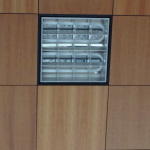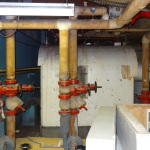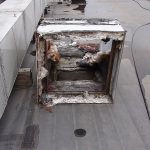On a recent walk through of a client’s 50 year old building our CEO was amazed at the poor condition of some of the energy-intensive components of the building. The client wants The Energy Alliance Group of Michigan to do a complete “green renovation” of their facility and the walk through was the start of that process.
The building and the operation it contains are very energy-intensive. The building owner wants to reduce any waste of energy or unnecessary energy consumption in order to improve his profitability.
The walk-through showed a marked deterioration in the various energy technologies. It appeared that no one was responsible for the upkeep or maintenance of the energy infrastructure and it had become a hodgepodge of decaying technology that was in a sad state of disrepair. That disrepair came with a price tag – a tremendous waste of energy and expense.
30% of the $200B spent annually on commercial utility bills in the U.S. is waste! Lean & Green Michigan
Following the walk-through our CEO developed the following list to help potential clients analyze their own operations and determine where maintenance or replacement could bring about the greatest benefits.
Here are the 5 most common areas of wasted energy and increased energy expense in older industrial buildings:
1. Insulation – Insulation that has been torn, compressed, retaining moisture, missing or is simply inefficient due to old technology, creates a huge opportunity for energy leakage from a building. Upgrading building insulation can result in energy savings of 30 percent.
2. HVAC – Heating, Ventilation and Air Conditioning (HVAC) use a tremendous amount of electricity and fuel. HVAC and lighting account for 70% of the utility bill for most commercial and industrial facilities.* Poorly maintained or outdated technologies use a great deal more energy than the newer systems which have steadily improved rates of efficiency. Coupling the HVAC with automated system controls greatly magnifies those efficiencies.
 3. Lighting – Old buildings typically use lights that are inefficient and are either on or off based on old light switch devices. Advances in lighting technology can offer energy savings of up to 20 percent. Using occupancy-sensor lighting fixtures as well as lighting control computerized programs can help reduce commercial lighting costs by an additional 45 percent.
3. Lighting – Old buildings typically use lights that are inefficient and are either on or off based on old light switch devices. Advances in lighting technology can offer energy savings of up to 20 percent. Using occupancy-sensor lighting fixtures as well as lighting control computerized programs can help reduce commercial lighting costs by an additional 45 percent.
4. Windows – Poorly designed windows leak air and lose energy. They can also create a green house effect that drives up the cost of air conditioning. Replacing old windows with newer models can increase efficiency up to three times. Simply adding energy efficient film to existing windows can also greatly decrease energy waste.
 5. Chimney – Chimney exhaust contains a lot of wasted heat and moisture. In most old buildings it simply rises up into the atmosphere and is forgotten. New technology can capture a large percentage of that heat and moisture and recycle it into other uses within the building. The water can be used for irrigation. The retrieved heat can cut down on gas usage.
5. Chimney – Chimney exhaust contains a lot of wasted heat and moisture. In most old buildings it simply rises up into the atmosphere and is forgotten. New technology can capture a large percentage of that heat and moisture and recycle it into other uses within the building. The water can be used for irrigation. The retrieved heat can cut down on gas usage.
“According to the United States Department of energy, commercial buildings could be made 80 percent more efficient with new and existing technology.”
What The Energy Alliance Group has found is most building owners don’t know how inefficient their building has become over time or how wasted energy is affecting their profits. They also have no idea what technologies are available to improve efficiency. Their biggest concern is how much will it cost to become energy efficient and how much money will they ultimately save (will the savings offset the expense). An important factor that is often a complete unknown is what programs are available to make the whole project affordable (rebates, incentives, financing). To help address those concerns the Energy Alliance Group of Michigan has created a free report entitled Ten Questions to Ask Before an Energy Efficiency Upgrade. It is the first step in determining if energy savings are possible for older facilities.
* Untapped Potential of Commercial Buildings – Energy Use and Emissions “indoor lighting, combined heating, ventilation and cooling (HVAC), and refrigeration account for the highest rates of electricity consumption per square foot.”


Leave a Reply